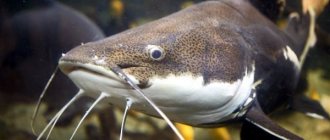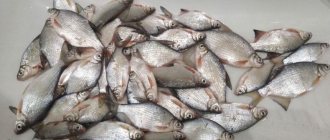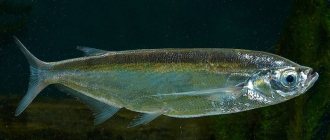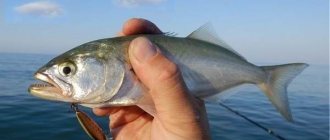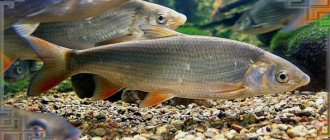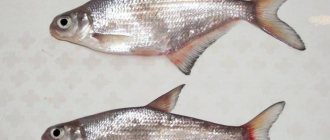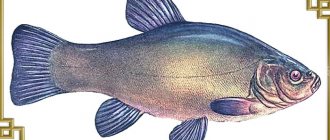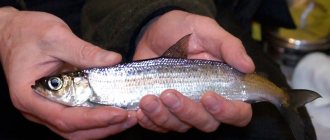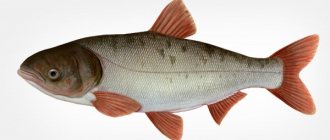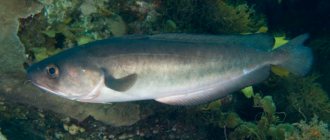- Wild animals
- >>
- Fish
The river eel is a very interesting fish, because in appearance it looks more like a snake, and it can also cover a distance of several kilometers on land. It is also prized by gourmets: its meat is considered very tasty. Not least because of this, the population of the species has decreased significantly, so that many countries are taking measures to protect it.
Origin of the species and description
Photo: River eel
The prototype is considered to be a small chordate Pikaia, which lived on Earth 530 million years ago. They were small in size - only a few cm, but at the same time, the way eels move is very similar to them - they move in the same way, bending their body. But this similarity should not be deceiving: unlike lampreys, eels are ray-finned fish, that is, they originated only many millions of years later. Although conodonts, one of the first jawless fish that lived in the late Cambrian, also resembled eels in appearance.
Ghostomes appeared in the Silurian period: it, as well as the next two, Devonian and Carboniferous, is considered the time of the greatest flowering of fish, when they were the most diverse and largest animals on the planet. But little remains of the species that lived on the planet at that time; most of the current diversity of fish arose much later.
Video: River eel
Bony fish, which include eels, arose at the beginning of the Jurassic period or at the end of the Triassic. At the same time, the first representatives of the eel order could have arisen, although researchers do not have a consensus on this issue: some believe that they occurred later, at the beginning of the Paleogene.
Others, on the contrary, relying on finds of fossil creatures similar in structure, attribute the origin of their ancestors to more ancient times. For example, such an extinct fish as Tarrasius is known, dating back to the Carboniferous period and very similar to the eel in structure. But the prevailing point of view is that this similarity does not mean they are related. The river eel was described by C. Linnaeus in 1758, the name in Latin is Anguilla anguilla.
Interesting fact: The oldest eel, his name was Putt, lived in an aquarium in Sweden for 85 years. It was captured as a baby in 1863 and survived both world wars.
Habitat
The eel is considered a species that appeared on our Earth about 100 million years ago. The eel was first discovered in ocean waters near Indonesia, but then it was spotted in seas, rivers and lakes across the planet, which are considered to be their intermediate habitat. The largest populations were seen in the basins of some water bodies, such as:
- Baltic Sea.
- Mediterranean Sea.
- White Sea.
- Sea of Azov.
- Barencevo sea.
- Black Sea.
- North Sea.
Being in any body of water, the eel chooses for its life activities areas of reservoirs with a clay bottom covered with mud. In summer, it likes to be in places overgrown with sedge and reeds. During the daytime it prefers to stay in shelter, and when darkness falls it goes out hunting.
This fish is also interesting because, if necessary, the eel is capable of crawling overland from one body of water to another, and over a considerable distance. As a rule, in this way it gets into lakes, which always have water. Eels have a special skin structure that allows them to absorb oxygen. Therefore, the eel can live for some time without water. Oddly enough, the fish always chooses the right direction and does not wander in the grass, looking for a new habitat. At the same time, they can change the direction of movement if they encounter bare ground or sandy areas along their path.
While in the river, the eel prefers to stay in quiet but deep areas. When the water level rises significantly, it can be found even during the day in various pools.
Appearance and features
Photo: What a river eel looks like
Eels have a very long body, which makes them look much more like snakes than fish - previously, because of this, in some countries they were not eaten, since they were not considered fish. In fact, it is not just a fish, but also very tasty: eels are considered a delicacy, although their appearance may indeed seem repulsive.
The color of the eel can be different: the back is olive, dark green or brown with a green tint - it depends on where it lives. As a result, it is difficult to see the fish when looking at the water from above. Its sides and belly can range from yellow to white - the eel usually becomes lighter in color as it matures.
The scales are very small, and its skin is covered with a layer of mucus, making it smooth and slippery - the eel can easily wriggle right out of your hands, so you need to handle it very carefully. The fish can grow to a maximum height of 1.6-2 m and weigh 3-5 kg.
The eel's head is apparently flattened from above, its body is cylindrical in shape near the head, and gradually becomes flatter as it approaches the tail. When moving, the eel bends its entire body, but primarily uses its tail. Its eyes are pale yellow and very small even for a fish, which also gives it its originality.
The teeth are small but sharp, arranged in rows. The fins, except the pectoral ones, are fused and very long: they begin at some distance from the pectoral ones and continue to the very tail of the fish. The lateral line is clearly visible. The eel is very tenacious: it may seem that its wounds are so severe that it must die, but if it still manages to escape, most likely after a few months it will be almost healthy, unless it has suffered a broken spine.
Types of acne
The eel family is not so numerous, so it includes only a few species, which are practically no different from their relatives, but live in different places, so there are 3 types of eels:
- The river eel lives in the basins of many rivers and seas. It grows up to 1 meter in length and can weigh about 6 kg.
- The sea eel is slightly larger in size compared to the river eel. It can grow up to 3 meters in length and weigh about 100 kg. The conger eel has practically no scales.
- Electric eel . It got its name from the fact that it is capable of generating electric current. It grows up to 2.5 meters in length, weighing about 40 kg. Electricity is produced by a special organ. Thanks to this feature, individuals protect themselves from enemies and also use electricity to hunt small fish.
Electric eel (lat. Electrophorus electricus)
Where does the river eel live?
Photo: River eel in water
The river eel is also sometimes called the European eel, because it lives almost exclusively in Europe: beyond its borders it is found only in North Africa and in a small range in Asia Minor. In Europe, it’s easier to say where it is not: in the Black Sea basin. It is found in rivers flowing into all other seas washing Europe.
Of course, this does not mean that it is found in all rivers: it prefers fairly calm rivers with calm water, so it is quite rare to find it in fast mountain rivers. The largest populations live in rivers flowing into the Mediterranean and Baltic seas.
The river eel is widespread throughout Western and Northern Europe, but the border of its distribution to the east is very complex: it is found on the Balkan Peninsula up to the south of Bulgaria inclusive, but then this border sharply goes to the west and goes near the western coast of the Balkans. There are no river eels in Austria.
He lives in Eastern Europe:
- in most of the Czech Republic;
- almost everywhere in Poland and Belarus;
- in Ukraine it can be found only in a small area in the north-west;
- throughout the Baltic states;
- in the north of Russia up to the Arkhangelsk and Murmansk regions inclusive.
Its range also includes all of Scandinavia and islands near Europe: Great Britain, Ireland, Iceland. From its distribution area it is clear that it is undemanding to water temperature: it can be warm, as in the rivers of the Mediterranean Sea, and cold, as in those that flow into the White Sea.
Eels are also notable for the fact that they are able to crawl out of a reservoir and move along wet grass and soil - for example, after rain. Thus, they are able to travel up to several kilometers, as a result of which they may end up in a closed lake. It’s easy to live without water for 12 hours; it’s more difficult, but still possible, for up to two days. They spawn in the sea, but spend only the first time and the end of their life there, the rest of the time they live in rivers.
Now you know where the river eel is found. Let's see what this fish eats.
Eel in the aquarium - maintenance
Some types of eels are suitable for keeping in aquariums. To do this, you need to use large containers so that you can build dummies of caves and grottoes on its bottom or simply lay out a thick layer of sand. Its neighbors in the aquarium must be large fish so as not to become part of the food chain. For comfortable living conditions for the conger eel, it is necessary to maintain the water temperature within 26°C and a salinity level of 22-24 ppm.
Did you like the article? Share with your friends:
What does the river eel eat?
Photo: River eel fish
The eel diet includes:
- amphibians;
- small fish;
- caviar;
- shellfish;
- insect larvae;
- worms;
- snails;
- chicks.
They hunt at night, with young ones usually in shallow water very close to the shore, and adults, on the contrary, in deep water further away from it. You can catch them during the day, although at this time they are less active. They mainly hunt for small fish that live near the bottom, such as sculpins. If they cannot find it, they can rise to the surface.
Eel, especially young ones, is one of the main destroyers of eggs of other fish, especially carp. He loves it very much, and during the period of active spawning in May-June, it is caviar that becomes the basis of his menu. Towards the end of summer it switches to feeding on crustaceans and eats many fry.
They specialize in fry of pike and tench, so in those rivers where there is a lot of this fish, there are usually also eels. It is noteworthy that they can feed not only in water, but also on land: they crawl ashore to catch an amphibian or snail. A large eel can intercept a waterfowl chick.
Although they hunt in the dark and have poor eyesight, they are able to accurately determine the location of the prey if they are at a distance of 2 meters or closer to it, and they also have an excellent sense of smell, thanks to which they can smell it from afar. Glass eels eat mainly larvae and crustaceans - they themselves are still too small and weak to catch amphibians, small fish or even fry.
Fishing methods
Since the river eel is a predatory fish, the bait must be appropriate. As a rule, to catch it you will need objects of animal origin, such as worms, pieces of meat, and also small fish. When using worms, it is better to prefer large worms and place them on the hook one at a time. Small worms will also work, but you need to plant several of them.
Good results can be obtained by using live bait, and from the same body of water as the object of fishing.
The following can be used as live bait:
- Roach.
- Rudd.
- Podleschika.
- Bleak.
The size of the fish is about 4 cm, although you can also use a dead fish.
For best results, it is better to feed the fishing spot a few days before fishing. For this, chopped worms and small fragments of fish are used. On the day of eel fishing, it is better not to feed the fish.
The most favorable period for eel fishing begins in mid-May and lasts until early June. This is due to the fact that during the hibernation period the fish became very hungry and are ready to swallow any bait. With the arrival of summer, and even more so autumn, you will have to give preference to a rather weighty bait - meat or small fish. The most productive fishing will be at night, and especially in bad weather with a strong thunderstorm.
A fisherman's experience is just as important as knowledge. When fishing with a worm, it is better to make the hook at the moment of the first bite, and if fishing is carried out with fish fragments, then the hook should be done at the time of the second bite. The fact is that after the first bite, the eel swims to the side to turn its prey in its mouth and only after that it swallows it.
It is not so easy to pull out an eel that is caught on a hook, since it is a dexterous and resourceful fish. It will offer serious resistance, clinging to branches or snags that are under water. In addition, you won’t be able to pick it up with your hand, and you shouldn’t count on catching it without a net. The eel is quite slippery, so even with a net there are problems getting it out of the water. When an eel needs to be removed from the hook, care must be taken to ensure that it does not slip out. If this happens, it is unlikely that it will be possible to catch it, and it will quickly end up in the water again.
In general, holding an eel in your hands is a real problem, since the fish is abundantly covered with mucus. Killing him is just as problematic, except perhaps breaking his spine.
European eel meat is valued for its taste, as it is tasty and soft. This is a fish from which various dishes are prepared. In some countries, smoked eel is considered a real delicacy and almost a national product and is served as a main course.
FISHING EEL. NIGHT FISHING for EEL and CATFISH on the LAKE
Features of character and lifestyle
Photo: River eel in Russia
Eels are active at night, but spend their days resting in burrows, or simply lie at the bottom, buried in the mud - sometimes to a depth of up to a meter. Eel burrows always have two exits, usually hidden under some stone. They can also rest near the shore, in the roots of trees: the main thing is that the place is calm and cool.
They spend most of their time near the bottom or on it; they like to hide in shelters, which are various snags, boulders or thickets. At the same time, great depth is not necessary: it can be either the middle of the river or a not too deep place not far from the shore. But they sometimes appear on the surface, especially if the water rises: at this time they are found in thickets of sedge or reeds near the shore, in pools nearby. They prefer when the bottom is covered with mud or clay, but in places where it is rocky or sandy, this fish is unlikely to be found.
From the end of spring and throughout the summer, the eel moves: they descend with the current and then swim to the spawning grounds, covering very long distances. But eels spawn only once (after which they die), and they live for 8-15 years, and in some cases much longer, up to 40 years, therefore only a small part of them participate in the process. In winter, eels hibernate by burrowing into the river bottom or hiding in their burrow. They practically do not react to external stimuli; all processes in their body slow down greatly, which allows them to consume almost no energy and not eat at this time.
But by spring they still lose significant weight, so after waking up they begin to actively fatten up. Most eels go into hibernation, but not all: some remain active in winter, this mainly applies to the inhabitants of warm rivers and lakes.
Use of the ingredient in cooking
Eel is a favorite product of gourmets due to its tender soft meat, the taste of which compares favorably with other seafood. “Snake fish” is slightly similar to salmon in the structure of the meat, but the flavor and aroma are different.
Freshwater eels are especially popular in the European and Asian regions. Their meat gives off a pleasant sweetish trail. Eels are served as an expensive but incredibly tasty delicacy. In Japan, preference is given to river and sea eels. Traditional soups and stews are prepared from them. In Germany they love to smoke fish and serve it as an appetizer. In China, eel is the most important element of national delicacies. A special casserole is prepared from the fish with garlic, green onions, bamboo shoots, soy sauce, rice wine and the pearl of the dish - eel.
During travel, a traveler may be offered to taste raw eel meat. Under no circumstances agree to an exotic offer! The blood contains toxic substances that poison the body and can cause many health problems. When cooked, toxic substances are destroyed, and the meat becomes absolutely safe.
What to combine the product with
Eel combination table
| Spices | Vegetables | Greenery | Fruits | Cereals | Beverages | Seafood/meat |
| Carnation | Tomato | Salad | Lemon | Rice | Sherry | Chicken |
| Pepper | Onion | Parsley | Orange | Beans | Cider | Salmon |
| Thyme | Garlic | Nori | Lime | White wine | Shrimps | |
| Sage | Capers | Mandarin | ||||
| Mustard | Olives | Pomelo | ||||
| Bay leaf | Grapefruit |
Unagi-Yanagawa Soup Recipe
Nutritional value (per 1 serving of prepared dish)
| Calorie content | 535 kcal |
| Squirrels | 31.2 g |
| Fats | 35.6 g |
| Carbohydrates | 20.8 g |
Culinary tip: soup can be used not only as a first course, but also as a sauce. Combine the sauce with meat, seafood, cereals and even vegetable salads. Please note that the consistency is quite thin, so the sauce will be used up in just a few uses.
We will need:
- chicken egg – 1 piece;
- smoked eel – 150 g;
- lettuce to taste – 5 g;
- Shiitake mushrooms – 20 g;
- green onions – 50 g;
- soy sauce – 25 ml;
- sweet rice wine – 20 ml;
- sugar – 5 g;
- seaweed – 3 g;
- tuna flakes – 5 g.
Preparation
Prepare a saucepan, mix 150 ml of ice water, sugar, soy sauce, seaweed and sweet rice wine. Bring the mixture to a boil, then add the tuna flakes. Lightly stir the ingredients, remove the saucepan from the heat, and strain the resulting mixture thoroughly. In a separate container, mix 1 egg with chopped lettuce leaves.
Grind green onions and shiitake mushrooms until coarse. Place the ingredients in a cold frying pan, place medium-sized eel slices on top, pour in the sauce (the liquid should not completely cover the ingredients) and bring to a boil. As soon as the dish boils, turn off the heat and add the egg with lettuce.
Unagi-Yanagawa should be served immediately after cooking, before the soup has cooled and lost the necessary taste.
Social structure and reproduction
Photo: Giant river eel
To spawn, eels from all rivers swim into the Sargasso Sea. To do this, they have to overcome long distances: for those fish that live in Russian rivers, up to 7,000 - 9,000 km. But they are swimming exactly there - to the place where they themselves were once born. It is in this sea that ideal conditions exist for eel larvae, called leptocephali. Spawning takes place at great depths - 350-400 m. The female eel spawns 350-500 thousand small eggs, each approximately 1 mm in diameter, after which it dies.
After hatching, the larvae are almost transparent - this provides them with good protection from predators. Only their black eyes are visible in the water. They are so different from their parents that they were previously considered a different species altogether - scientists have long been fascinated by the mystery of eel reproduction, and the name leptocephala was assigned to their larvae.
After the leptocephalus is born, it floats up and is picked up by the Gulf Stream. Along with this current, leptocephali gradually float towards Europe. At the stage when the fish is already close to the shores of Europe, and then enters the mouths of rivers, it is called a glass eel. By this moment, the fish grows to 7-10 cm, but immediately on the approach to the river it stops feeding for a long time and decreases in size by one and a half times. Her body changes, and she becomes similar in appearance to an adult eel, rather than a leptocephalus, but still remains transparent - hence the association with glass.
And already when ascending up the river, the eel acquires the coloration of an adult, after which it spends almost the rest of its life there: these fish remain in the river for 8-12 years, and constantly grow, so that by the end of their life they can grow up to 2 meters .
physical characteristics
Freshwater representatives are very similar to snakes, but this is only a superficial resemblance. Their exterior is amazing. The bodies are covered with a thick layer of mucus. They lack pelvic ribs, and many species also lack pectoral fins. The dorsal and anal fins are connected to the caudal fin, forming a single stripe running along a large part of the body.
The female reaches up to 200 cm in length and weighs up to 9 kg.
Males are smaller than females and reach a length of up to 60 cm (the so-called lace) and a weight of up to 0.35 kg.
The general characteristics are as follows:
- The body is elongated, 5 cm long. Depending on the species, they can grow from 1.2 to 4 m in length. The length of the record individual was 6 meters, and its weight was 72 kg.
- Adults weigh from 1.1 kg to over 25 kg.
- They usually have pointed heads with sharp teeth. Individuals that live deep in the sea are usually gray or black. Individuals that live in tropical areas have bright patterns and colors.
- They swim by generating body waves that travel along the length of their bodies. They can flow backward, inverting the direction of the wave.
Depending on the environment in which they live, their bodies acquire a lighter or darker color. Some individuals can be almost black, while others have an olive tint. In addition, the shape and size of the snout depend on the ecosystem in which the fish is found. First of all, it depends on food.
And therefore, individuals with a narrow head are found where they have the opportunity to feed on small crustaceans, larvae and worms. In places where fish and larger amphibians predominate, it adapts its mouth to this type of food, due to which the muzzle becomes many times wider.
The appearance of the larvae was so different from the adults that for a long time the leptocephala (as it is technically called) was considered a separate group. The larvae have a smooth, transparent, highly flattened lateral and elongated body with micro internal organs. They are also an exception among vertebrates because they have no red blood cells or hemoglobin in their blood.
Natural enemies of the river eel
Photo: River eel
There are no specialized predators that hunt mainly for eels. In nature, practically no one threatens adult individuals at all as long as they remain in the river: they are large enough not to be afraid of river fish or birds of prey. But in the sea, a shark or tuna can dine on them.
Young eels that have not yet grown to large sizes can be threatened by predatory fish, such as pike, or birds: cormorants, gulls, and so on. And yet it cannot be said that even for a young eel there are many threats in the river. Of course, it’s more difficult for very young fish, not to mention leptocephali: many predators feed on them.
But the main enemies of the eel are people. This fish is considered a delicacy, because it has very tender and tasty meat, which is why it is actively hunted. Not only fishing, but also other human activities have a negative impact on the eel population. Water pollution has a negative impact on their population, as does the construction of dams that prevent them from spawning.
Interesting fact: Why eels swim so far to spawn has not yet been established; there are different theories on this matter. The most common explanation for this is continental drift: previously it was close for eels to swim to the Atlantic Ocean, and even now, when the distance has increased greatly, they continue to do so.
Leonid Pavlovich Sabaneev
Rice. 45. Eel embryo
Until recently, the reproduction of eels remained very obscure, and even now it has not yet been fully studied, which depends, of course, on the fact that the eel goes to the sea for this purpose. In earlier times, Aristotle, then in the 16th century, Rondelet attributed spontaneous generation to eels, and the popular belief is still widespread that eels are born spontaneously in swamps.
Back in the fifties of this century, Schilling expressed the opinion that eels belong to hermaphrodites, since, despite all his efforts, he could not find a single fish that did not contain ovaries. These ovaries have the shape of long ribbons, extend the entire length of the abdominal cavity and until the end of the last century were mistaken for plates of fat; they contain a huge number (several million) of extremely small testicles, so that in most cases they are difficult to distinguish with the naked eye. Only in 1873, in Trieste, Syrsky managed to find (in the estuaries and in the sea) male eels, which turned out to be sharply different from females; firstly, by the fact that they are never found in the river, and then by their small size (up to 50 cent.), bronze metallic skin color, large eyes and low dorsal fin. Further studies showed that eels spawn in the sea, in December and January, on muddy shallows, and from the fact that many times it happened to find dead female eels with empty ovaries in the world, they conclude that eels, like lampreys, spawn only once in a lifetime.
The migration of eels (Calata - in Italy), or rather their rolling into the sea, begins in the upper reaches of rivers and in the north earlier than in the south. In the vicinity of Oranienbaum, the strongest movement and the most important fishing occur during July and continue until the fall or half of September, so, probably, spawning here occurs in the fall and not in winter[9]. All individuals that have reached sexual maturity, usually at the age of five, roll down only at night and at certain intervals; on moonlit nights the course is suspended, and in general the main course of eels occurs mainly on dark, stormy and stormy nights. In November (in the west), all adult individuals already leave fresh water, and at this time their eggs reach a size of ¼ millimeter. Young eels partly remain in the sea, partly rise (at night) into rivers - in Italy in February, in Germany and England in May and June - in countless schools, overcoming all obstacles encountered along the way and even entering completely enclosed pools. During this move (montee, montata) eels are from 1 to 8 centimeters in length, but by autumn they grow to 20 centimeters.
Near Comachio, on the south side of the river mouth. However, there are lakes that, with the help of sluices, are deliberately adapted for catching eels. In the spring, the sluices open, so that young eels can freely enter the lakes and settle in them; in the fall, the sluices are closed and special gear is inserted into them to catch old eels that are trying to go out to sea. It has been noticed that eels remain in lakes for 5-6 years and, having reached 3-8 pounds there, go down[10]. Let us also note that the eels of Lake Onega, where they are quite numerous, are probably not always capable of reproduction, since they are not always able to find their way back to the sea. This is indicated both by the fact that predominantly very large eels are found here (more than 2 arshins in height and weighing from 10-15 pounds), and by the fact that recently they have become much less common than before, although I do not catch this fish here at all are engaged in and those caught in the maselgi (perets) are thrown into the water or used for rendering fat.
Under ordinary conditions, the eel grows quite slowly, reaching a length of 3½ feet no earlier than in the fifth or sixth year of life, but, however, continues to grow for a very long time, so that sometimes indivisible individuals are found that are up to 6 feet long (according to Ekstrem ) and are thicker than a person’s arm. According to Kessler's observations, an eel 1.6 feet long weighs about 2 pounds, and an eel 3.2 feet long weighs 3.5 pounds; In addition, there are indications that an eel 4 feet tall weighs from 8 to 10 pounds, and therefore it must be assumed that the largest eels must weigh at least 20 pounds.[11]
According to Baer, in Narova they use bag-shaped nets, the so-called, to catch eels. portages. They have a volume of 5 soot. and are attached to the threshold, that is, poles, a fathom long. The main fishing takes place at the very source of the Narova River from Lake Peipsi. Here in the river there are stakes or sezhi, consisting of piles, which are placed at a distance of a fathom from one another, in the form of goats across the river up to half of it. Thick boards lie on trestles. The fishermen, standing on these boards, place these portages in the space between the goats, pressing them to the bottom with a long pole. The open end of the portage faces the source of the river. In the southern part of Lake Onega, a large number of eels were previously caught using orders of hook tackle - nets baited with small fish.
In Germany, according to Moerbe, eels are caught in large numbers with frequent nets and rod tops, which are placed b. hours at night, less often (only in standing waters) and during the day. To bait eels, green pea pods on stems or even just pea grass, panicles of hemp, small fish, frogs and the hind legs of frogs are placed in these shells, or a skinned frog is hung inside (in the baby); in this case, it is recommended to first soak the animal bait in a mixture of honey and heron fat. Often they also catch eels here by lowering fagots of brushwood (alder) with a stone at night, inside of which there is some kind of bait, for example pea grass. Eels crawl into the brushwood; In the morning, the fisherman carefully lifts the fagot and quickly throws it onto the shore or into the boat.
In addition, you can catch a lot of eels in holes and under stones using a net. Having first felt the fish (which it is not afraid of if done carefully) and determined its position, if it sits with its head outward, with the other hand they bring a net to it (close and strong) and then firmly pinch its tail; The eel immediately jumps out of the hole and falls into the net. In this way, you can catch any other fish that hides in holes, under stones, snags, and other secluded places, especially burbot, and, in any case, it is much more convenient to catch this way than with your hands (see “Burbot”). Finally, the Germans catch eels in old wooden pipes or pumps, one hole of which is plugged, and bait (frog legs) is tied near the other, and the pipe is immersed in water using stones. In the morning, the projectile is removed, but it is necessary to be together, because the eels that have crawled into the pump quickly jump out of the hole; one lifts the pipe, and the other places a net under the hole, into which the fish fall. It may very well be that here in Russia there will also be hunters who will try to catch eels using these simple methods.
There is almost no information about the fishing of eels in Russia, that is, in the waters belonging to the Baltic basin. It is only known that eels are caught with a fishing rod both in the Neva and in many areas of the Baltic Sea and Prislensky lips. and in the Northwestern Territory. We only know, from the words of Terletsky, that the eel bite in the Western Dvina begins in June, when it takes well on bottom fishing rods, and that the bite, at first quiet and unnoticeable, turns into a strong swing of the rod.
In Western Europe, fishing for this fish is very common and is done in quite a variety of ways, some of which, no doubt, can be used by Western Russian fishermen. For this reason, and also due to the lack of information about eel fishing in Russia, I find it necessary to give brief descriptions of almost all methods of catching eels with fishing rods in Germany and France.
Catching eels with fishing rods begins in Western Europe in the spring and lasts for the most part until the beginning of October, since in November the eels either go to sea (adults) or bury themselves in the mud, often in whole balls, and remain in hibernation until the onset of warm weather (we probably have until the hollow water is drained). Since the eel is a nocturnal fish and during the day hides in holes, brushwood, stones and similar shelters, it is rarely caught in the middle of the day or in special ways, in holes, or only after a warm night thunderstorm and on very hot days before a thunderstorm, when it comes out of burrows closer to the surface of the water and stays under the shade of aquatic plants. However, in the spring, after a long winter fast, the eel takes well even around noon.
Like all nocturnal fish, the eel has a very developed sense of smell, and it is not difficult to lure it by throwing pieces of intestines rolled out in the sand, pieces of fallen stones, or dropping a weighted bladder filled with blood and with a small hole into the water where they intend to catch. , from which blood would leak. Many German authors advise making the bait itself fragrant. Some are content to first dip it in Provençal or rosemary oil, others advise to flavor the bait by putting it (overnight) in a mixture (of equal parts by weight) of Bogorodskaya herb, honey and tallow renderings (cracklings); This mixture is dissolved on coals and then diluted with flour (wheat) mash, almost until the thickness of lard. In some cases, when eels swim on top, they are fed with peas (green) or boiled hemp seed, ground with green peas.
The eel is caught using a wide variety of baits, and it can rather be called an omnivorous fish, although the bread bait itself, it seems, is not used anywhere. For the most part, it is fished in spring and summer for crawlers and red worms, and in the fall for small fish - live, and in the absence of such, dead: minnows, loaches, lampreys, small loaches, minnows, small smelt, also for pieces of fish, best of all lamprey In addition, in many places in Germany and France, hooks are set with green, and in the absence of it - with steamed peas, beans, Swiss cheese (see “Barbel”), and in the fall - with small frogs (the hook is stuck into the anus and pierced the thigh, so so that the frog can swim) or on skinned frog thighs; also for pieces of beef, even corned beef, and for liver cut into worms. Careful Germans, keeping in mind the eel’s highly developed sense of smell, advise putting on the nozzle with clean hands, but they believe that this is both unnecessary and inconvenient.
The eel has a small mouth and always swallows the bait, and therefore hooks should not be larger than No. 5, and it is even better to use No. 7-8, but with a thick shaft (Kirby extra strong flatted; also Virginia hooks); For ease of removal, Alquen recommends straight hooks (without bending to the side) with the tip pointing strongly outward. Live bait is also always attached to single hooks, which are passed into the mouth and nostril. Since the eel has, although very small, sharp teeth with which it can grind silk or hair fishing line, it is generally more prudent to tie hooks to basque or wire leashes, and when fishing at night with several fishing rods and lines, this is even necessary. It seems that the basque and wire can be replaced by heavily spun hemp leaders. The fishing lines must be very strong and durable - silk or hemp, as well as the fishing rods, and the reel should never be used with them. It is impossible to tire an eel, and you should not fish for it if you do not want to risk losing fish and gear. An eel, feeling caught, always tries to hide in a hole, brushwood, under snags, or wraps itself around underwater objects. In such cases, even the most reliable tackle often does not help and you often have to tear it off, if possible at the leash, or wait for the fish to perhaps release the line.
The eel's bite is very reliable; this fish is very greedy and rarely releases the bait, which, however, is explained by the fact that the eel often gets its teeth so stuck in it that it cannot immediately spit it out. In general, you should not delay hooking, especially when fishing with small baits - pieces of fish, peas, etc., and pull out the eel immediately after hooking, without any ceremony, trying only to drag it away from the water. When pulling out a net is used very rarely, because, firstly, it often slips into the loops, pushing them apart or breaking them, and secondly, because, wriggling, it wraps the fishing line around itself. For the same reason, having pulled the eel ashore, first of all they step on the fishing line near the hook with their foot (otherwise the eel will tangle it) or hold it taut so that the fish’s head is raised all the time. Then they cut its spine at the head or at the tail, or, after rubbing their hands with sand or earth, they take the fish by the head and hit the tail against some hard object (even a heel). The tail is the most sensitive place of the eel, since here, directly under the skin, there are two so-called lymphatic receptacles, the contraction of which can be easily distinguished[12]. You can also take the eel with a silk or woolen handkerchief, and A. Carr even says that you can hold it in such a way that the middle finger is on top and the index and ring fingers are below. But, it goes without saying, you can only hold a small eel in your hands. Rühlich advises fish over 3 kilograms. (more than 7 pounds) handle with care, as a large eel, entwined around your hand, can break it.
It is difficult to remove live eels from the hook, but this is not necessary, because, being planted in a basket, and even more so in a net planter, they often leave. It is best to place them in baskets with a tight lid, the bottom of which is lined with a fairly thick layer of damp moss. In the same baskets, eels are transported over considerable distances. According to Morisot, an eel in a damp and fresh place (for example, in a cellar) can live without water for 6-8 days.
The hook is usually swallowed quite deeply, and for the most part it has to be pulled out using a metal knitting needle ending in forks (see “Pike”).
Actually, fishing includes: fishing with a float, fishing with a bottom fishing rod without a float, in a plumb line or cast, then fishing with a needle and fishing without a hook. With a float they usually fish with a large worm, mounted in scallops, or with several dung ones, but the sting of the hook must be well hidden, since a well-fed eel is very careful. The float needs to be light, and the sinker, also small, should lie on the bottom along with the nozzle. The eel takes the bait into its mouth slowly; The float sometimes falls down at first, but you should hook it only 2-3 seconds after it disappears under the water. They hook very sharply and strongly and, as said, immediately pull out the fish, just in case, away from the shore. Occasionally, just when eels swim on top, mostly after bad weather or a thunderstorm, they are caught in muddy water using a floating fishing rod, and the bait (mostly green peas) should be shallow from the surface. When fishing by weight in places with a more or less strong current, the weight of the sinker should correspond to the latter; rods are used both long and, when fishing from a boat (in deep places), short. When fishing with a cast, with long lines, you fish only with short rods, and there is no need to hold them in your hands and you can fish with several. The sinker, especially in fast places, is preferable here to a round bullet, drilled through and freely sliding along the fishing line, to the leash, where it is retained by a pinched pellet. Such a mobile sinker makes it possible to feel the weakest bite in your hand. The tip of the rod when fishing without a float should therefore be quite flexible and sensitive. Bottom fishing is mostly done in deep places, for example, in harbors, docks, and river mouths.
Fishing with a needle and a bunch of worms without a hook is used mainly during the day, when the eel is sitting in its burrows. These burrows are similar to those made by water rats and are often visible from the shore. The presence of eels in them is recognized by a small cloud of turbidity produced by the breathing and movements of the hidden fish. It is possible, of course, although not so successfully, to catch using these two original methods, especially the first, and where eels have the habit of hiding in brushwood or stones. Fishing with a needle, which originates from Scotland, consists in general terms of weakly sticking a needle into the end of a long stick or rod, on which a worm is put; This needle is tied in the middle to a strong fishing line, which is held in the right hand, while with the left hand they carefully lower the stick into the water, at the opening of the hole, so that the worm at the end of the fishing rod touches the edges of the latter. If an eel sits in it, then it will not fail to grab the worm, tear it off the stick and swallow it. When hooking, the swallowed needle, tied to the middle, becomes across the throat or stomach; the fish cannot free itself from this crossbar, and it is pulled out of the hole onto the shore.
In all likelihood, this method of fishing, in a more or less modified form, can be applied to fishing other greedy fish, especially burbot, and therefore I consider it necessary to describe it in more detail. The fishing rod, of course, has nothing to do with it, and all that is required of it is length and lightness; sometimes 1-2 arshins of wire are tied to a simple stick, on the bent end of which a worm (put on a needle) is hooked by the tail or head, or, also, instead of sticking a needle into the end of a stick-rod, the worm is pinched in the fork that ends this stick. The needle should be quite thick (best used by tailors for buttonholes) and no longer than 2 inches, which is why the thick part with the eye is sawed off and sharpened. The fishing line is strong, but thin, hemp (basque leash is inconvenient) or silk; the end of it is secured to the needle using a thin silk rubbed with varnish, similar to a tie on hooks, but only in the opposite direction, since it is required that the fishing line be attached to the middle of the needle. A worm is better than an ordinary earthen worm (small) or a large dung worm; First, the entire needle is threaded into its front part, then its thick end is passed into the tail, as shown in the figure (Fig. 46). It goes without saying that you should not rush into hooking and that you should drag the eel out of the hole carefully, without loosening the fishing line. Sometimes, for convenience, the fishing line is wound on a hand reel; in this case, it is useful to let the fish first reel in (or reel in themselves) a few inches of line.
Fishing for worms strung on a woolen cord is less productive and successful, based on the fact that the eel, having tied its small teeth in this cord, cannot immediately release them. Several large earthworms are threaded onto a short woolen cord using a needle; the ends of the cord are connected, the worms are arranged in a heap or festoon, and in the middle of this heap a fishing line with a heavy sinker is attached. The rod should be long, strong, and since you have to fish at different depths (often significant), it is useful to use a reel to shorten and lengthen the fishing line (see its picture, “Trout”) - Fish without a float, in a plumb line, slightly lifting and lowering the nozzle and leaving it alone for a few minutes - where there are many holes. The eel, seduced by the abundance of food offered to it, grabs the bait; at the same moment, with a quick movement they pull him out of the water, without giving him time to unclench his teeth.
In addition to this method, in Germany they often catch eels using dead fish, with a large float made from a bunch of reeds and a stone, so that the eel cannot drag away the tackle. The fish is attached as follows: the leash with the hook is cut off and, using a needle, passed through the mouth into the anus so that the hook sticks out of the mouth. In order for the fish to lie standing on the bottom, like a living one, the sinker must be in its belly. The cord is tied to one end of the float, and the same one is tied to the other
Population and species status
Photo: What a river eel looks like
Previously, the eel population in European countries was very large. In some places they were not caught at all, considering them inedible, or they were even fed to livestock, since many eels were still caught as bycatch. This is especially true in the Iberian Peninsula, where many juvenile eels have been caught.
In other countries, they have been actively consumed and loved for a long time, and even more of them were caught there. This led to the fact that the population of this fish decreased significantly by the second half of the 20th century. Fishing for eels is still carried out, however, its scale has noticeably dropped due to a drop in the number of fish.
Back in the late 1990s, 8-11 thousand tons were caught annually, but by that time it became noticeable that the population had decreased. It continued to fall in recent decades, as a result of which the scale of fishing became much more modest. Now river eel has become much more valuable.
Its fry in Spain are now sold for 1,000 euros per kilogram as a delicacy for the rich. The river eel is listed in the Red Book as a species on the verge of extinction, however, its fishing has not been prohibited - at least not in all countries. The International Union for Conservation of Nature's recommendation is to limit its catch.
Distribution of the conger eel
The northern part of the Atlantic Ocean off the coast of Europe and Africa, as well as America and adjacent seas to depths of 300 m. Conger also lives in the Mediterranean and Marmara seas, the Bosphorus, from where single individuals enter the Black Sea. Near the American coast it is found from Cape Cod to Brazil. It is found in the Indian Ocean and off the coast of Asia in the Pacific Ocean, but is not found in the eastern half of the Pacific Ocean.
Moray and conger eel


